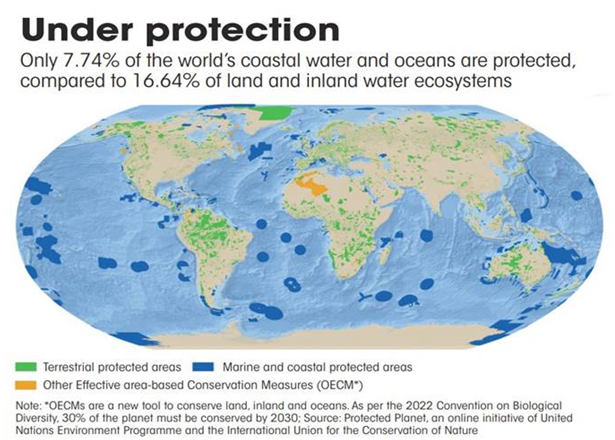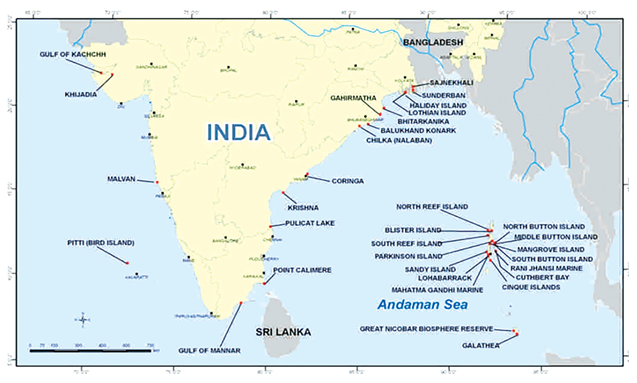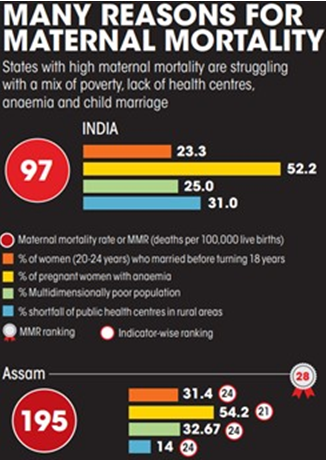Down To Earth(March1-15 2023)
1. MARINE CONSERVATION
- Montreal, Canada hosted 15th Conference of the Parties to the UN Convention on Biological Diversity (CBD) where 196 countries signed a pact to fulfil the 30X30 target. Experts again met in Feb, 2023 in Vancouver during the 5th International Marine Protected Areas Congress (IMPAC5) to plan for 30X30.
About 30X30 target:
- This target calls for 30% of the earth’s land and sea area to be conserved through the establishment of protected areas (PAs) and other area-based conservation measures (OECMs).
- There are mainly two tools to achieve the goal:
- designating an area as a Marine Protected Area (MPA)
- through Other Effective area based Conservation Measures (OECM)

- Roughly 10 million square km of oceans must be annually brought under protection over the next seven years to meet the 30 per cent target.
MARINE PROTECTED AREA (MPA)
- MPA is owned by the government, with the primary objective of long-term conservation by limiting human activities.
- It also offers nature based solutions to support climate change adaptation and mitigation.
OTHER EFFECTIVE AREA BASED CONSERVATION MEASURES (OECM)
- OECMs can be owned by communities, governments, and for-profit and non-profit organisations.
- OCEMs can achieve long-term conservation by enabling communities’ social, economic, and cultural well-being.
Indian Initiatives:
- There are a total of 31 major Marine Protected Areas in India covering coastal areas that have been notified under Wildlife Protection Act, 1972.
- India has no OCEM, but plans to use the tool to reach the 30 per cent target. Till now 14 potential OECM sites have been identified by the National Biodiversity Authority of India.
- It has conserved around 27 per cent of its geographic area, with about 22 per cent under terrestrial coverage and 5 per cent under coastal and marine coverage.
- Prominent examples include the Gulf of Mannar Marine National Park, Sundarbans National Park, Gulf of Kachchh National Park, Gahirmatha Marine Sanctuary, Coringa Wildlife Sanctuary and Chilika Wildlife Sanctuary etc.

Benefits of OCEM over MPA:
- OECMs are a better tool for India since it has a large human population.
- MPAs limit human activities and negatively impact livelihood of land and coastal communities but this is not so with OCEM.
- There is a greater role of non-profits to ensure that countries do not misuse OECMs to increase their protected areas for meeting the 30 per cent target.
2. FOREST RIGHTS
- Madhya Pradesh launched Van-Mitra Portal in 2019 to facilitate the Forest Rights claims of the tribals and forest dwellers but has been criticised as it allows officials to unilaterally reject the claims.
FOREST RIGHTS ACT, 2006
- The Forest Rights Act (FRA), 2006 recognizes the rights of the forest dwelling tribal communities and other traditional forest dwellers to forest resources, on which these communities were dependent for a variety of needs, including livelihood, habitation and other socio-cultural needs.
- The Act provides for Individual rights and Community Rights (Grazing, Fishing, etc), Habitat Rights for PVTGs, access to biodiversity, community right to intellectual property and traditional knowledge, recognition of traditional customary rights and right to protect, regenerate or conserve or manage any community forest resource for sustainable use.
Objective:
- To undo the historical injustice towards forest dwelling communities.
- To ensure land tenure, livelihood and food security of the forest dwelling Scheduled Tribes and other traditional forest dwellers.
- To strengthen the conservation regime of the forests by including the local communities.
Back Story:
- The Supreme Court while hearing the case on constitutionality of FRA, 2016 directed the states to evict those whose claims had been rejected. This meant eviction of 1.19 million people, across 16 states. This order was put on hold later.
- The Ministry of Tribal Affairs then discussed the order with the states concerned, which decided to review the rejected claims.
- MP with highest tribal population gave a chance to tribals to get their Individual Forest Rights (IFR) claim reviewed through Van-Mitra Portal.
- MP received 1,74,525 IFR claims of which it has processed 1,51,929 and rejected 1,16,758 claims i.e. a rejection rate of 76.9 per cent.
Problem for forest dwellers:
- Forest dwellers are often not literate and go to registered internet kiosk operators for online form filling, who upload improper documents, often mixing up documents of different individuals.
- The panchayat, talukdar and the forest department’s beat guard are required to visit and verify the claimed area.
- They often reject the claim without a physical visit.
Pan-India Problem:
- Total 14 states have rejected 5,43,432 IFR review claims taking rejections to almost 50 per cent of the review claims.
- Chhattisgarh tops the list of the states in rejecting review claims.
- Odisha has reviewed 1,48,870 rejected IFR claims and rejected 1,40,504 out of them.
Possible suggestions for better implementation of FRA:
- Empower Gram Sabha and increase their participation in decision making. This includes regular meetings of Gram Sabhas in these areas and no proxy meetings.
- Proper recording of forest claims.
- Sensitization and training of forest officials to process forest claims.
- Educating forest dwellers about their rights and ways to ensure its enforcement.
3. CHILD MARRIAGE IN INDIA
- Child marriage remains a chronic problem throughout India, even though it has been banned since 1929 (the Child Marriage Restraint Act). Recent crackdown of Assam Government on child marriages using the Prohibition of Child
- Marriage Act, 2006 (PCMA) along with the Protection of Children from Sexual Offenses Act, 2012 (POCSO) has been criticised for being too harsh. Child marriage has been a deep rooted problem in India and has multiple causes.
- Prohibition of Child Marriage Act, 2006 (PCMA)
- PCMA, 2006 forbids child marriages in India for all its citizens.
- It fixes 18 years as the minimum marriageable age for women and 21 years for men.
- There are provisions for punishment of 2 years or fine up to 1 lakh rupees or both under PCMA.
- The PCMA Amendment Bill 2021 seeks to increase the minimum age of marriage of females to 21 years to bring it at par with males.
- Protection of Children from Sexual Offences Act, 2012 (POCSO)
- The Act has been enacted to protect children from offences of sexual assault, sexual harassment and pornography etc. and defines a child as any person below eighteen years of age.
- It recognises non-bailable, cognisable offences which means that the police can make an arrest without warrant and a person can be imprisoned for up to 20 years.
- It provides for establishment of Special Courts for trial of such offences and related matters and incidents.
Why did Assam act on Child Marriages?
- As per 2018-20 Sample Registration System report, Assam has the highest maternal mortality rate (MMR) in the country, at 195 deaths per 100,000 live births while the national average is 97.
- Child marriage increases the risk of maternal mortality as minors are not mentally or physically prepared for childbirth.
- Thus Assam cracked down on Child Marriages to arrest and improve the condition of MMR.
Data on Child Marriages in India:
- As per NFHS-5 by the Union Ministry of Health and Family Welfare In 2019-21, 23.3% women between the age of 20 and 24 years were married before turning 18 (i.e one out of four) and 61% are married by age 21.
- Child marriage is most prevalent in West Bengal (41.6 per cent), followed by Bihar (40.8 per cent), Tripura (40.1 per cent) and Jharkhand (32.2 per cent). In Assam, the share is 31.8 per cent.

Reasons for Child Marriages in India:
Poverty
- Low level of education of girls
- Lower status given to the girls and considering them as financial burden
- Social customs and traditions

Initiatives to curb Child Marriage in India:
- The Central Government also undertakes awareness drives, media campaigns and outreach programmes.
- The Ministry of Women and Child Development implements the ‘Beti Bachao Beti Padhao (BBBP)’ scheme.
- Schemes like Dhanalakshmi, Sukanya Samriddhi Yojana, Balika Samridhi Yojana etc.
Mains Questions
- The Forest Right Act still acts as a half measure in ensuring welfare and empowerment of tribal and forest dwellers Comment
QUICK LINKS